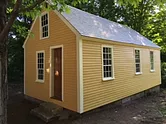
This is Ashland, NH's web site devoted to restoring the home built by Reuben Whitten where he lived in 1816.

Ashland resident and songwriter Paul Hubert liked the story so much that he wrote a song for it.
1816 in New England became famous for its lost crops due to repeated cold events during the growing season. I forget when I first learned about the year, but I learned about a granite monument to it in Ashland NH in a 1979 article in Scientific American by Henry Stommel that included a photograph of it.
I finally hunted it down when I decided it would be a good Geocache, and found it on chilly day, May 17, 2002. The next day while I was cooking breakfast, rain changed to snow. 1816 weather the day after I find and touch the monument!
I wrote a web page about the year's impact on New Hampshire to extend the description in the Geocache and also to make it available to people outside of Geocaching. See 1816: The Year without a Summer - A New Hampshire Perspective
For the 200th anniversary in 2016, I decided to write a much longer essay looking at the weather that led to events of the year. There is a lot of data available, not on the web, but in various historical libraries. For New Hampshire, my primary reference is a farmer's journal maintained by our governor at the time, William Plumer. It may be the only such journal in the state, though I think Dartmouth College may have temperature data too.
See Summer of 1816 in New Hampshire: A Tale of Two Freezes or see a variant with many comments at the blog Watts Up With That.
The following link is for a .pdf file scan of William Plumer's weather journal. The link is somewhat hidden from search engines because a Chinese search engine seems to think it's a good idea to download another large .pdf file every day.
There are some other related pages on the subject:

This is Ashland, NH's web site devoted to restoring the home built by Reuben Whitten where he lived in 1816.

Ashland resident and songwriter Paul Hubert liked the story so much that he wrote a song for it.
Contact Ric Werme or return to his home page.
Written 2016 Jun 7, last updated 2025 Apr 25.